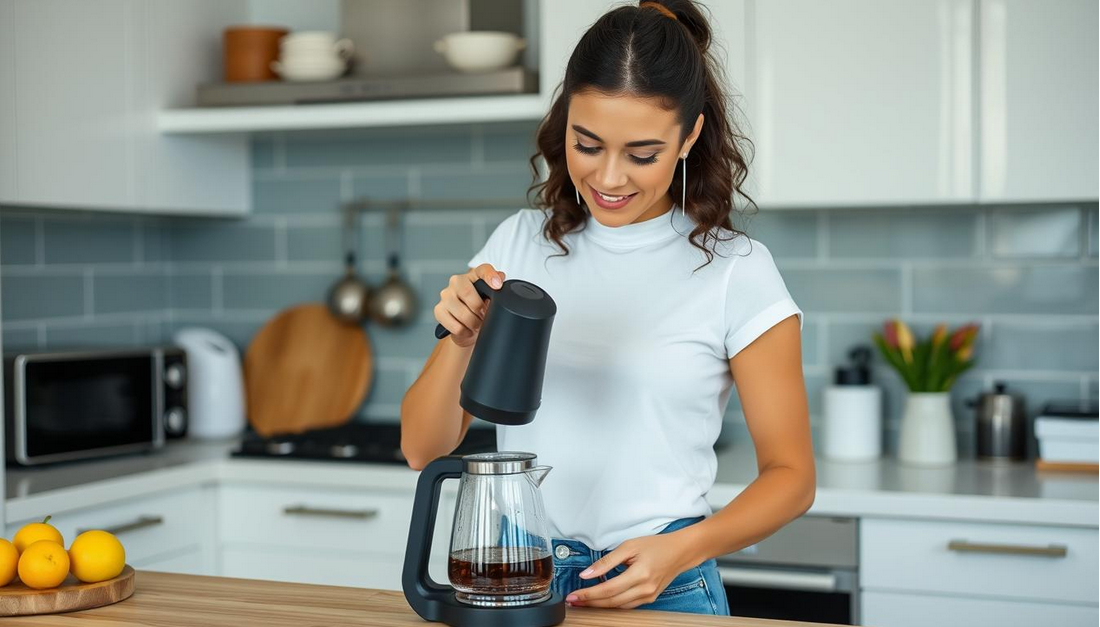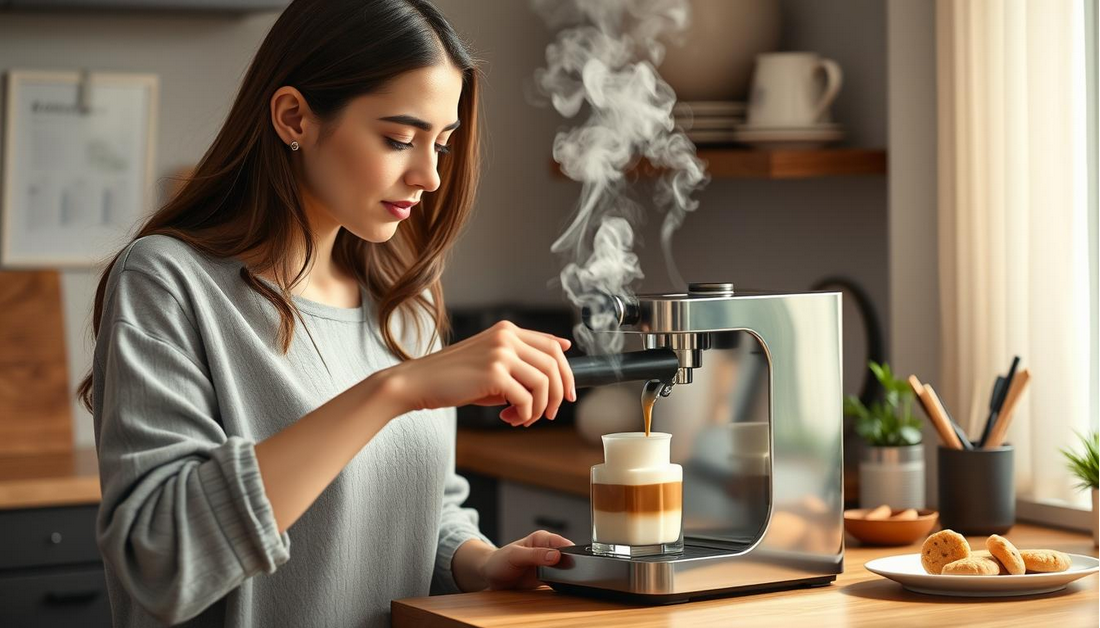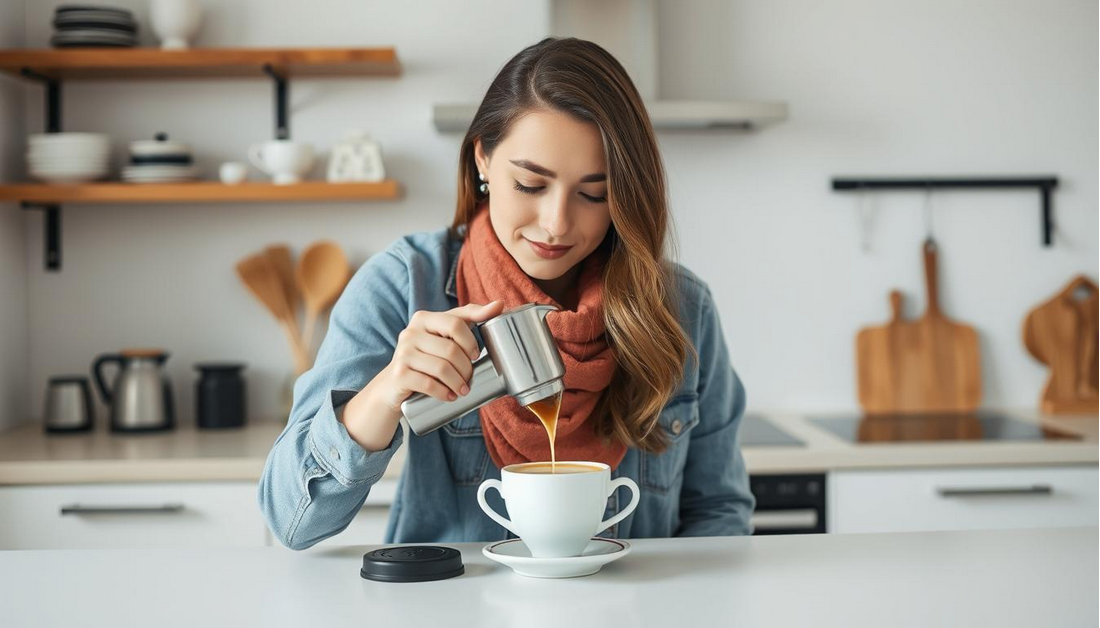India customers to view on amazon.in
What’s the Secret to a Barista-Quality Brew at Home?
Ever wondered how coffee shops make every cup taste perfect? You can make barista-quality coffee at home without fancy equipment. This guide shares the secrets pros use, like precise grinders and the right water.
- Understanding What Makes Café Coffee Special
- The Science Behind Great Coffee
- Consistency: The Professional Barista’s Secret
- The Importance of Fresh Ingredients
- Essential Equipment for Your Home Coffee Station
- What’s the Secret to a Barista-Quality Grind?
- Burr vs. Blade Grinders: The Critical Difference
- Dialing in Your Grind Size for Different Brewing Methods
- Consistency and Particle Size Distribution
- Water Quality: The Overlooked Element
- Mastering Different Brewing Methods
- Espresso: Pressure, Time, and Temperature
- Pour-Over Perfection: Technique and Timing
- French Press: Full Immersion Brewing
- AeroPress and Moka Pot: Alternative Methods
- The Art of Milk Texturing and Latte Art
- Achieving Microfoam: Temperature and Technique
- Basic Latte Art Patterns for Beginners
- Alternative Milks and Their Unique Properties
- Coffee Bean Selection and Storage
- Common Mistakes That Ruin Home-Brewed Coffee
- Improper Ratios and Measurements
- Temperature Issues and Their Solutions
- Neglecting Equipment Maintenance
- Conclusion: Your Journey to Barista-Quality Coffee at Home
- FAQ
- What’s the best way to brew coffee like a barista at home?
- How do I choose the best coffee beans for home brewing?
- What are some common coffee brewing mistakes to avoid?
- How can I froth milk like a barista?
- What’s the difference between burr and blade grinders?
- How can I improve coffee taste at home?
- What is the best coffee-to-water ratio for brewing?
- Can I make espresso at home without an espresso machine?
- How do I properly store coffee beans?
- What equipment do I need to make barista-quality coffee at home?
It’s not just about following a recipe. It’s about the techniques that make a difference. Say goodbye to weak or bitter coffee.

Home coffee brewing secrets are often simple. They can make a big difference. Learn the best tips for making coffee at home, from choosing fresh beans to mastering pour-over or espresso.
No more guessing. This article shows you how to turn your kitchen into a café. Anyone can master it.
Key Takeaways
- Master how to brew coffee like a barista with easy-to-follow steps.
- Discover the role of grind size and water temperature in achieving barista-quality results.
- Understand why proper bean storage and fresh ingredients matter for flavor.
- Learn the basics of equipment like burr grinders and pour-over kits.
- Get actionable advice to avoid common mistakes and save on daily café costs.
Understanding What Makes Café Coffee Special
Learning to make café-quality coffee is all about the basics. Barista tips and specialty coffee secrets can transform your home brews. With professional brewing techniques, anyone can brew like a pro at home. Let’s explore the science and habits that make a difference.

The Science Behind Great Coffee
Flavor comes from extraction science. The right water temperature and grind size are key. They help dissolve acids and oils. Aim for a balanced brew with these factors:
- Water temperature: 195–205°F (90–96°C) unlocks optimal flavors
- Grind size matched to brewing method (fine for espresso, coarse for French press)
- Contact time: 2–4 minutes for most methods
Water quality also affects taste. Hard water hides acidity, while filtered water brings out clarity. This is why why water quality matters in coffee.
Consistency: The Professional Barista’s Secret
Top cafés rely on consistent steps for every cup. Follow these professional brewing techniques:
- Use digital scales for precise bean-to-water ratios
- Time each step with a stopwatch
- Adjust grind size daily based on bean freshness
The Importance of Fresh Ingredients
Freshness is crucial. Fresh coffee beans vs. pre-ground is a big deal. Pre-ground beans lose 80% of their flavor in 2 weeks. Store beans in airtight containers away from light. This keeps your coffee fresh and flavorful. Avoid pre-ground blends for the best aroma and body.
Essential Equipment for Your Home Coffee Station
Creating a top-notch coffee station begins with the right tools. Each must-have coffee brewing tools is crucial for turning beans into a delicious drink. Let’s look at what you need for your kitchen café.

- Essentials: A best coffee grinder for home use (like the Baratza Encore) ensures consistent particle size. Pair it with a best coffee scales for precise brewing (try the Acaia Pearl) to get the right water-to-coffee ratio. Choose a versatile brewer, such as a V60 or French press, to try different coffee brewing methods.
- Nice-to-Haves: A gooseneck kettle (Fellow Stagg is a hit) offers precise pour control. Reusable metal filters boost eco-friendliness without sacrificing taste.
- Luxuries: For espresso lovers, the best espresso machine for home like the Breville Barista Express adds professional pressure. A milk frother for home baristas (e.g., Aerolatte Pro) whips silky microfoam for cappuccinos.
“Invest in quality grinders first—they’re the foundation of every great cup.” — Sarah L., Coffee Roaster
Start small. Master basics like the best coffee grinder for home use and scales before splurging on an espresso machine. Upgrade gradually as your skills grow. No need to buy everything at once—your home café evolves with you.
What’s the Secret to a Barista-Quality Grind?
Perfect coffee begins with the right grind. Whether you’re making espresso or pour-over, the grind’s consistency and size are key. They set the stage for bold, balanced flavors. Here’s how to achieve it.
Burr vs. Blade Grinders: The Critical Difference
Blade grinders chop beans like a blender, leading to uneven particles. This ruins the coffee’s extraction. Burr grinders, on the other hand, crush beans between wheels for uniformity. For best coffee beans for espresso, a conical burr grinder is essential.
The main difference? Blade grinders make bitter, inconsistent shots. Burr grinders, however, ensure espresso perfection every time.

Dialing in Your Grind Size for Different Brewing Methods
How to grind coffee for different brews varies by method. Here are some starting points:
- Espresso: Fine powder, like table salt. How to dial in espresso shots involves adjusting until water flows slowly.
- Pour-over: Medium grind, similar to granulated sugar.
- French press: Coarse, like sea salt.
Too bitter? Try a coarser grind. Sour? Go finer. Adjust slowly, one step at a time.
Consistency and Particle Size Distribution
Uniform particles ensure even understanding coffee extraction levels. Fines (tiny pieces) can over-extract, causing bitterness. Boulders (large chunks) under-extract, leaving sour flavors.
To balance how to balance coffee strength and flavor, aim for 18-22% extraction. Use a refractometer to measure.
Mastering pre-infusion technique for espresso starts with perfect grind consistency. The goal is for every particle to extract equally. This delivers a rich, full-bodied shot.
Water Quality: The Overlooked Element
Many people don’t realize how important water quality is for coffee. Tap water with too much chlorine or minerals can hide coffee’s natural flavors. On the other hand, soft water might make it taste flat.
Start by testing your tap water’s hardness and pH. You can buy kits for under $10 that give you instant results.

To improve your coffee at home, start with filtering. A basic carbon filter pitcher can remove chlorine and sediments. For even better taste, try using third-wave water recipes.
These recipes mix filtered water with minerals like magnesium and calcium. Aim for 50–150 PPM total dissolved solids (TDS) for the best extraction levels.
| Mineral | Ideal Level | Impact |
|---|---|---|
| Calcium/Magnesium | 50–100ppm | Enhances acidity and body |
| Chlorine | 0ppm | Damages flavor; filter out |
| pH | 6.5–7.5 | Maintains optimal extraction |
For sustainable brewing, reuse mineral additives or choose eco-friendly pitchers. Adjust your brew by fine-tuning the coffee-to-water ratio—start with 1:16. This ratio balances strength and flavor, avoiding bitterness.
Understanding extraction levels means avoiding weak or bitter tastes. Simple fixes like filtered pitchers or distilled water can change your morning coffee. Your water’s chemistry is the secret ingredient in every sip.
Mastering Different Brewing Methods
Unlock your coffee’s potential with these method-specific techniques. Whether you’re crafting espresso or experimenting with immersion brews, precision matters. Start with the right tools and follow these step-by-step guides for flawless results.

Espresso: Pressure, Time, and Temperature
Master coffee tamping techniques for better espresso by distributing grounds evenly. Use a bottomless portafilter to spot channeling instantly. For how to make espresso at home, aim for 9 bars of pressure and a 25–30 second extraction. Adjust grind size to control flow rate—coarser grinds slow extraction, finer grinds speed it up.
Pour-Over Perfection: Technique and Timing
Follow this pour-over coffee guide for clarity. Start with a bloom: soak grounds with twice the water weight for 30 seconds. Use the Rao spin—slow, circular pours—to ensure even saturation. Optimal water temp: 195–205°F. Example: 30g coffee, 500g water, 3-minute brew time.
French Press: Full Immersion Brewing
French press brewing tips require patience. Coarse grind + 4-minute steep = bold flavor. Press slowly to avoid over-extraction. Pro tip: preheat the carafe with hot water before adding grounds.
AeroPress and Moka Pot: Alternative Methods
Try aeropress brewing techniques for versatility: invert the device for clean flavor or use standard mode for body. For moka pot coffee brewing, fill the chamber without submerging the safety valve. Adjust flame intensity to avoid burnt flavors.
| Method | Grind Size | Water Temp (°F) | Brew Time | Key Tip |
|---|---|---|---|---|
| Espresso | Fine | 195–205 | 25–30 sec | Check portafilter for even extraction |
| Pour-Over | Medium | 200–205 | 2:30–3:00 | Bloom first, pour in spirals |
| French Press | Coarse | 200–205 | 4 minutes | Steep, then press slowly |
| AeroPress | Fine to medium | 175–195 | 1:30–2:00 | Inverted method reduces bitterness |
| Moka Pot | Medium-coarse | N/A (stove) | 4–6 minutes | Use medium heat to avoid scorching |
The Art of Milk Texturing and Latte Art
Turn regular coffee into a fancy drink with the right milk handling. How to steam milk for lattes begins with texture. You need smooth microfoam for latte art. Try different best milk for cappuccinos and lattes to find the perfect mix of sweetness and foam.

Achieving Microfoam: Temperature and Technique
Heat the milk to 150°F while spinning the pitcher. This mixes air and liquid. Aim for silky creating microfoam for latte art without big bubbles.
Don’t have a steam wand? Use a handheld frother. Shake it hard for 20 seconds. To froth milk like a pro, tilt the pitcher and listen for the “hiss” sound.
Basic Latte Art Patterns for Beginners
- Pour milk slowly into the espresso’s center.
- As you finish, raise the pitcher to create a white heart—how to pour a perfect latte heart is all about timing.
- For rosettas, move the pitcher side-to-side when the cup is half full.
Mistakes happen? Don’t worry! Overpouring? Just start again. Mastering latte art tips for beginners takes 10-15 tries. Watch how the milk flows—it’s all about speed and angle.
Alternative Milks and Their Unique Properties
- Best non-dairy milk for coffee: Oat milk (Oatly) holds foam well but needs colder starts. Soy (Silk) creates dense microfoam but may separate if oversteamed.
- Almond milk (Almond Breeze) thins easily—use it cold for lighter lattes.
- For cappuccinos, whole dairy milk builds the creamiest foam. Avoid skim for this.
Adjust your techniques based on the milk type. With patience and practice, you’ll get pro-level results.
Coffee Bean Selection and Storage
Choosing the best coffee beans for home brewing means looking at specialty coffee beans from places like Ethiopia or Colombia. Each has its own taste. Make sure to check the roast date—beans are best 7–14 days after roasting.
Pre-ground coffee is not as good because it loses its smell faster. If you like espresso, try Blue Bottle Coffee’s Kenya AA or Stumptown’s Hair Bender.

Keeping beans fresh means fighting off air, moisture, heat, and light. Store them in airtight containers at room temperature. Use best home coffee subscription services like Trade or Counter Culture for fresh beans every month.
For syrups, make your own best homemade coffee syrups with local honey or vanilla extract. It adds a rich flavor.
“The key is balance—fresh beans and mindful storage keep coffee tasting vibrant.” — Sarah Lee, Barista Champion
| Category | Recommendations |
|---|---|
| Best for espresso | Intelligentsia Coffee, Verve Coffee Roasters |
| Storage tools | Ziplock bags, airtight canisters |
| Subscription services | Blue Bottle, Atlas Coffee Club |
Try different best coffee beans for home brewing to find flavors like floral or chocolatey. Use the right storage to keep them fresh. Your taste buds will love it!
Common Mistakes That Ruin Home-Brewed Coffee
Even with top-notch beans and equipment, small mistakes can mess up your coffee. Steer clear of these common coffee brewing mistakes to avoid to get the best taste in every cup.

Improper Ratios and Measurements
Not using scales and just guessing the coffee amount can lead to uneven results. Real baristas stick to the best coffee-to-water ratio of 1:16 to 1:18. Too little coffee makes it weak, while too much makes it bitter. Get this right to how to balance coffee strength and flavor like a pro.
- Use digital scales for precision
- Adjust ratios per brew method (espresso vs. French press)
Temperature Issues and Their Solutions
Water that’s too cold under-extracts, leaving it sour. Water that’s too hot can burn the beans. Aim for understanding coffee extraction levels by brewing between 195°F–205°F. For pour-overs, preheat the dripper with hot water first. Cold brew? Use room-temp water and steep 12–24 hours.
“Temperature control is the silent hero of coffee flavor.” – Specialty Coffee Association
Neglecting Equipment Maintenance
Stale oils in grinders or mineral buildup in kettles? That’s coffee swag skills undone. Clean grinders monthly and descale espresso machines every 30 uses. Rinse presses after every use to avoid rancid oils. Fresh equipment ensures consistent coffee brewing like a barista every time.
Fix these issues, and your coffee will taste richer, cleaner, and more nuanced. Every adjustment brings you closer to café-quality at home.
Conclusion: Your Journey to Barista-Quality Coffee at Home
Learning barista skills at home is all about curiosity. It’s not just about the tools. It’s about the journey from grinding to steaming. Start with one skill at a time.
Practice makes perfect, but it’s okay to make mistakes. It’s all part of the learning process.
Now, let’s get creative. Coffee art can turn your drink into a masterpiece. Cappuccino tips will help you create smooth foam. Try adding spices or syrups to your lattes for a unique taste.
DIY coffee recipes let you create your own signature drinks. Add lavender or matcha for a seasonal twist. Every cup is a new adventure.
Try new recipes like homemade cold brew or iced coffee with citrus. Each recipe boosts your confidence. It shows that brewing coffee at home is a lifelong journey.
Share your creations and tweak recipes to your liking. The best coffee is the one that makes you happy. Keep trying, tasting, and exploring. Your perfect cup is always just around the corner.
FAQ
What’s the best way to brew coffee like a barista at home?
To brew coffee like a barista at home, start with high-quality, fresh coffee beans. Use a good burr grinder for consistent grinds. Try different brewing methods like pour-over or French press.
Remember to measure your coffee-to-water ratio for the best flavor.
How do I choose the best coffee beans for home brewing?
Choose specialty coffee beans that are freshly roasted and have tasting notes you enjoy. Try different origins to find your favorites. Always check the roast date to ensure freshness.
Buying from reputable suppliers can help you find quality beans.
What are some common coffee brewing mistakes to avoid?
Don’t use pre-ground coffee; use whole beans instead. Make sure to measure the coffee and water correctly. Neglecting equipment maintenance is also a mistake.
Clean your coffee maker regularly and adjust your grind size based on the brewing method to improve flavor.
How can I froth milk like a barista?
To froth milk like a professional, use cold milk and a steam wand if available. Heat it to about 150°F while incorporating air. For a manual method, use a milk frother or whisk vigorously until you achieve the desired microfoam texture.
Whole milk or whole-fat alternatives work best for frothing.
What’s the difference between burr and blade grinders?
Burr grinders use two revolving surfaces to crush coffee beans evenly, resulting in a consistent grind size. Blade grinders chop the beans with a blade, leading to uneven sizes that can negatively affect extraction and flavor.
For the best coffee, opt for a burr grinder.
How can I improve coffee taste at home?
Start by experimenting with your coffee-to-water ratio. Use fresh, high-quality beans and adjust your grind size for your chosen brewing method. Also, consider the water quality; filtered water can make a noticeable difference in flavor.
What is the best coffee-to-water ratio for brewing?
A common recommendation is to use a ratio of 1:16, meaning one gram of coffee for every 16 grams of water. However, feel free to adjust the ratio based on your taste preferences and brewing method, as some may prefer a stronger or milder brew.
Can I make espresso at home without an espresso machine?
Yes! You can use methods like the AeroPress or Moka pot to create espresso-like results. While they might not replicate the exact brewing conditions of a traditional espresso machine, they can produce strong coffee with rich flavor.
How do I properly store coffee beans?
To keep your coffee beans fresh, store them in an airtight container in a cool, dark place. Avoid exposing them to heat, moisture, and light to preserve their flavor. It’s best to only buy what you’ll use within a few weeks to maintain peak freshness.
What equipment do I need to make barista-quality coffee at home?
Essential equipment includes a good burr grinder, a coffee scale for precise measurements, and a brewing device that suits your style, such as a French press, pour-over setup, or espresso machine. Additional tools like a temperature-controlled kettle and milk frother can enhance your coffee experience.







